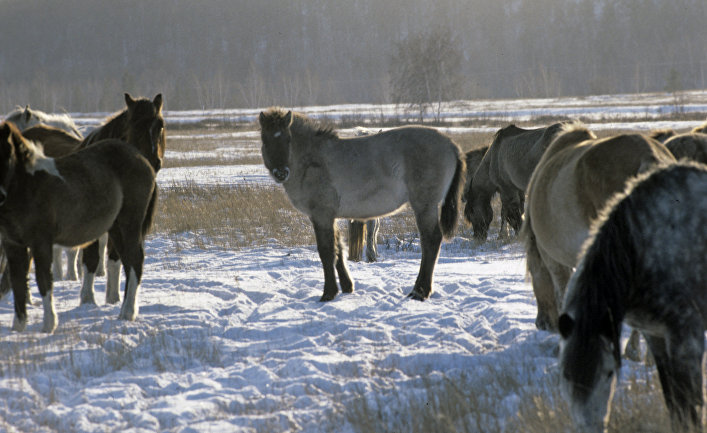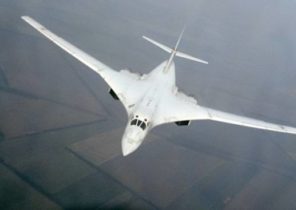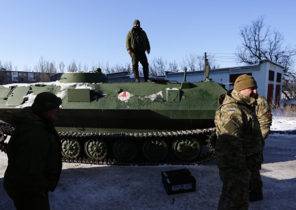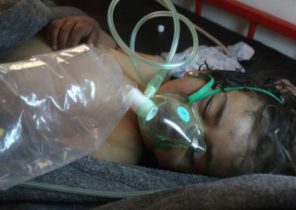
Young Yakut host tames the colt: he uttered it, trying to force to obey. The Mare worried watching the scene from behind the fence of the corral.
In the snow-covered larch forest, grazing a dozen Yakut horses with a thick mane and coat. From the breath of the horses steam rises.
Frost of twenty degrees for them uneasy, they dig through the snow in search of grass.
We are located in the Republic of Sakha (Yakutia), in the Siberian village of Sakkyryr, the coldest inhabited region of the world.
Every winter here note the temperature is below 55 degrees.
Human life here has become possible only after there Pets, such as horses, cows, and domesticated reindeer. They provide meat, milk and clothing, they are also used as means of transportation.
Scrubby Yakut horses have been called the most hardy horses in the world. They graze freely on the pastures themselves to earn their living. In winter they also sleep standing up.
“Russian horse looks for food itself, it must be kept in the stall and give her hay. And Russian horse breeds in winter,” Echenique local breeder Sergey Lukin.
The horse is the national animal of Yakutia. Only in Yakutia 250 thousand horses.
Horses go round, they arrange jumps, milking. In addition, they are grown for meat. The greatest delicacy is the meat of the foal.
Breeding Yakut horses reminiscent of reindeer husbandry. The work of shepherds is to search for the missing herd.
Hay give horses in the spring when they begin to starve. Yet not all individuals survive the winter. Natural selection is merciless.
But how the horse learned to survive here? What characteristics one must possess to survive in the harshest conditions in the world?
This explains Juha Rantanen (Juha Kantanen), Professor at the Centre for natural resources in Finland, dealing with genetics of domestic animals.
Rantanen with his band for the past 15 years studying the fauna Sakkyryr. Funded by the Academy of Finland, the Arctic project is exploring the issues of adaptability of domestic animals to the conditions of life in the North.
Rantanen will take blood samples in a field laboratory located in the car, and passes them to the vet Releas Tiina (Tiina Reilas) and researcher Jane, Pappa (Jaana Peippo).
Researchers are also interested in wandering trails Sakkyryr unusual-looking long-haired cows. These representatives of the aboriginal Yakut cattle here about eight.
Cattle are kept in winter in unheated barns and fed hay. In winter they have to do with poor food and daily go out to drink water from the polynya.
Cattle in Yakutia almost no pain and not receiving antibiotics.
Materials obtained Cantanta, was used by the Professor of the University of Copenhagen Louis Orlando (Ludovic Orlando) in his study of the adaptability of horses to cold.
According to research, the adaptation of cows and horses was the same, despite the fact that we are talking about different types of animals.
As in Yakut horses, and the Yakut cattle have short legs and a stocky body structure, which prevents heat loss. For the winter they have grows long and thick coat, which they shed in the spring.
It is important that adaptability is associated with the metabolism.
Horses and cattle eat for future use during a short vegetation period and delay the reserves, which they use effectively in the winter.
What matters is fat tissue. Energy is stored in white fat, which Yakut cattle receives 10-30% of the energy needed in the winter.
Group Kantanen came to Sakkyryr during the autumn slaughter of livestock, as they want to take fat samples.
The researchers also want to find out human involvement in adaptation of domestic animals. Professor of anthropology at the University of Lapland Florian Stammler (Florian Stammler) examines the question of selection of animals for breeding.
“An important factor for the horse is how well it can provide themselves with food in the winter. Colt, which keeps good weight in the first year, leave. The beast that is missing from the flock, or seek to go to the barn for the winter too early, look at with distrust. Unsuitable animals are sacrificed”.
Amazing speed of adjustment types.
Research Kantanen and Orlando showed that cows and horses belong to the same aboriginal species, as in other regions. The Yakuts brought them to the North, 800 years ago.
Thus, the adaptation to life in cold conditions occurred during a hundred generations of animals that evolution is for the moment.
How is that possible? The results indicate that epigenetics, that is genetic modification that is responsible for heredity in addition to genes and their mutations. The modification affects the gene produces protein or not.
So as to fit the required diversity, it was found to modify “cold”genes.
In Siberia hardened not only animals but also people.
During the autumn slaughter in the local Sakkyryr used to butcher carcasses and assorted inside many hours with his bare hands in the frost.
In accordance with studies, a man cannot within his life to get used to the cold, can only learn how to protect yourself from it, for example, by using heating or clothing.
However, as the people seem to be genetically adapted to cold almost in the same way as other mammals.
A group of Kivisild Toomas (Toomas Kivisild) from the University of Cambridge compared the DNA samples of ten indigenous peoples of Siberia and made important discoveries, particularly regarding the genotype of the Chukchi in northeastern Siberia and Eskimos.
These people are more active two genes that are responsible for metabolism, and a gene that prevents the loss of heat by compression of blood vessels.
The indigenous peoples of the North, there are changes in metabolism that hinder the increased content of fats and cholesterol in the blood, even if the foods are animal fats. The body uses fat as a source of energy and heat.
Have Kantanen in Siberia is “their cow”. He observes the life of eight cows throughout the year and strongly supports the conservation of the Yakutian cattle, which is endangered.
“This area of the North of Yakutia it is necessary to take under protection of UNESCO, because here is a rare image of a preserved indigenous breeds of cattle and Yakut reindeer herding”.
Indigenous breeds of cattle, according to Kantanen, form a significant part of the genotype and diversity.
“In indigenous breeds you can find the necessary genotype for home cattle. The great value has use of the feed and fertility. The study should be multifaceted”.
Survival of the Yakut horse is largely influenced by the fact that, despite the cold, Siberia little snow. Climate change could make life difficult.
“Warming is increasing,” says breeder Lukin. In some regions of Yakutia bad weather of late fall has brought an unprecedented, nearly two-meter snow cover. This prevents the horses to find food. Animals had to score.
Food is hampered by the fact that wet snow freezes, and its surface falls new snow. Wet snow that had fallen a horse, can cover the icy crust mouth or feet, and the animal can neither eat nor move.
“The animal will die after five days, if people don’t take the ice,” says Lukin.







